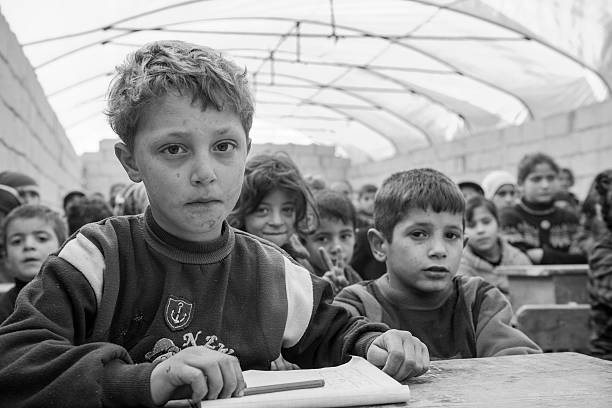Building Global Citizenship Awareness Through Contextual Learning: A Case Study of Children Affected by the Syrian Conflict

s2dikdas.fip.unesa.ac.id SURABAYA – The Syrian conflict, which has persisted for over a decade, has profoundly impacted millions of children, depriving them of basic rights such as safety, education, and a stable home environment. This crisis, while geographically distant from Indonesia, provides a critical context for nurturing global citizenship awareness among elementary school students. Through contextual learning, educators can bridge the gap between local classrooms and global realities, fostering empathy and a sense of responsibility in young learners.
Contextual Learning as a Tool
for Global Awareness
Contextual learning emphasizes
connecting academic content to real-world experiences, making lessons more
meaningful and impactful. By introducing the stories and struggles of Syrian
children into the classroom, teachers can create opportunities for students to
engage with global issues in a relatable and age-appropriate manner. This
approach not only enhances cognitive understanding but also cultivates
emotional intelligence, helping students develop empathy for others.
One effective way to implement
contextual learning is by using interdisciplinary teaching methods. For
example, teachers can incorporate stories about Syrian children into language
lessons, use their experiences to discuss geography and cultural diversity, or
explore the science behind humanitarian aid efforts. These connections make
learning more engaging and relevant, encouraging students to think critically
about global challenges.
Strategies for Contextual
Learning
- Story-Based Learning - Stories are a
universal way to communicate complex ideas in an accessible manner.
Teachers can share narratives about Syrian children who have faced
challenges such as displacement, hunger, and limited access to education.
These stories should be carefully selected to inspire hope and resilience,
focusing on themes like perseverance and community support.
For instance, a story about a
Syrian child who continues to learn despite losing access to formal education
can spark discussions about the importance of education and the barriers faced
by children worldwide. Students can be encouraged to reflect on what they would
do in similar situations, fostering a deeper connection to the issue.
- Interactive Activities - Contextual learning
thrives on active participation. Role-playing activities, for example, can
help students understand the difficulties faced by refugees. In a
simulated activity, students might take on roles as families navigating
challenges such as finding shelter, accessing food, or continuing their
education in a foreign country.
Such activities not only build
empathy but also enhance problem-solving skills as students work together to
overcome simulated obstacles.
- Collaborative Projects - Group projects
allow students to explore global issues more deeply. For example, a
project focused on Syrian culture and traditions can provide a positive
lens through which students learn about the country beyond its conflict.
This approach highlights shared humanity and promotes cultural
appreciation.
Students can create
presentations, posters, or digital content that showcases their findings,
sharing what they’ve learned with their peers and families.
- Integrating Art and Creativity - Artistic
expressions such as drawing, writing, or performing skits can help
students process complex emotions and ideas related to global issues.
Teachers might ask students to create art pieces inspired by the
experiences of Syrian children, encouraging them to imagine what it feels
like to live in a conflict zone.
- Connecting to Local Contexts - To make the
lessons more relatable, teachers can draw parallels between the challenges
faced by Syrian children and those faced by marginalized groups in
Indonesia. For example, discussing access to education for children in
remote areas of Indonesia alongside the struggles of Syrian refugees can
help students see the universal nature of these issues.
Overcoming Challenges in
Teaching Global Citizenship
Teaching about global issues like
the Syrian conflict can be challenging, especially when addressing sensitive
topics with young learners. Teachers must carefully curate content to ensure it
is age-appropriate and avoids overwhelming students. Focusing on stories of
hope and resilience rather than solely on tragedy can help maintain a positive
and constructive tone.
Another challenge is the lack of
resources or training for educators. Schools can address this by providing
professional development opportunities, equipping teachers with the tools and
knowledge needed to integrate global citizenship education effectively.
Collaboration with NGOs or international organizations can also provide
valuable resources and insights.
The Impact on Students
Teaching global citizenship
through contextual learning has a profound impact on students. It helps them
understand the interconnectedness of the world, fostering a sense of shared
responsibility for global challenges. Students who learn about issues like the
Syrian conflict are more likely to grow into compassionate individuals who
advocate for justice and equality.
Moreover, these lessons enhance
critical thinking and problem-solving skills, preparing students to navigate a
complex and interconnected world. They also instill values such as empathy,
respect for diversity, and a commitment to helping others, which are essential
for building a harmonious society.
The Syrian conflict is not just a
distant tragedy but a powerful teaching tool for fostering global citizenship
awareness among young learners. By integrating contextual learning into their
teaching practices, educators can inspire students to care about the world
beyond their immediate surroundings.
Through storytelling, interactive
activities, collaborative projects, and creative expressions, teachers can
bring the realities of global challenges into the classroom, making them
accessible and meaningful for students. These efforts lay the foundation for a
generation that is more empathetic, informed, and motivated to contribute to a
better world.
Author: Annas Solihin, S.Pd.
Photo Documentation: istock